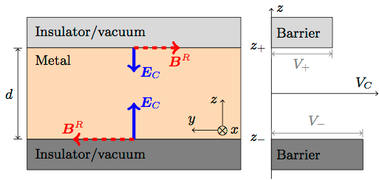Prof. Jiang Xiao and co-workers recently predicted that it is possible to conceive spin Hall effect in metallic thin films sandwiched by insulators without using nobel metals (such as Au or Pt), which is usually thought to be necessary for spin Hall effect. The result is published on Physical Review B 87, 081407(R) (2013) (Rapid Communications).

When a normal metallic thin film (without bulk spin-orbit coupling, such as Cu or Al) is sandwiched by two insulators (see right figure), interfacial spin-orbit coupling appears due to the gradient in the confining potenital, which then subsequently induces two prominent effects: 1) a giant spin-Hall effect due to the surface scattering as mentioned above, and 2) a transverse electric polarization due to the spin-dependent phase shift in the spinor wave functions.
The spin Hall effect and its inverse effect are essential in generating and detecting spin current in the spintronic applications. The sandwich-type structure proposed in this paper has the potential application to replace noble metals (such as Pt) as a source and detector for spin currents.
